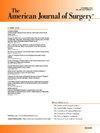腹腔镜入路治疗胆囊肠瘘:单中心经验和系统回顾
IF 2.7
3区 医学
Q1 SURGERY
引用次数: 0
摘要
背景:胆囊肠瘘是胆结石的一种罕见但公认的并发症。传统上,手术治疗采用开放入路。我们的目的是报告腹腔镜手术治疗CEF的安全性和结果,并对文献进行系统回顾。方法回顾性分析我院2015年1月至2023年12月行腹腔镜胆囊切除术的患者。我们确定了所有CEF患者的数据收集,包括人口统计学、临床表现、手术细节和结果。系统回顾了关于腹腔镜手术治疗CEF的安全性和结果的文献报道。结果2015年1月至2023年12月9年间4937例患者行腹腔镜胆囊切除术,其中19例确诊为CEF。平均年龄63.7岁。14例(73.7%)在术中确诊。肺炎是3例患者术前诊断的关键影像学特征。腹腔镜吻合器是最常见的缝合方法,共6例(31.6%),其次为腹腔镜手工缝合5例(26.3%)。打开转化率为36.8%。3例(15.8%)有轻微并发症,1例(5.3%)有胆漏。有一次30天的再入院。我们的队列中没有死亡病例。中位进食时间和住院时间分别为2.5天和6天。排除后,系统评价确定了7项研究,共145例患者。主要并发症发生率为2.8%,死亡率为1.4%。结论腹腔镜手术治疗胆囊肠瘘安全可行。在熟悉腹腔镜技术的外科医生中效果良好。本文章由计算机程序翻译,如有差异,请以英文原文为准。
Laparoscopic approach to cholecystoenteric fistula: A single-centre experience and systematic review
Background
Cholecystoenteric fistula (CEF) is a rare but well recognized complication of gallstones. Traditionally, surgical management was by open approach. We aim to report on the safety and outcomes of laparoscopic surgery for CEF and present a systematic review of literature.
Methods
All patients who underwent laparoscopic cholecystectomy in our institution from January 2015 to December 2023 were retrospectively reviewed. We identified all patients with CEF for data collection, including demographics, clinical presentation, operative details, and outcomes. Systematic review of literature reporting on safety and outcomes of laparoscopic surgery for CEF was performed.
Results
4937 patients underwent laparoscopic cholecystectomy over a nine-year period between January 2015 to December 2023.19 patients were diagnosed with CEF. Mean age was 63.7 years. 14 patients (73.7 %) were diagnosed intra-operatively. Pneumobilia was a key radiological feature leading to pre-operative diagnosis in three patients. Laparoscopic surgical stapler was most common fistula closure method with six cases (31.6 %), followed by laparoscopic handsewn closure in five patients (26.3 %). Open conversion rate was 36.8 %. Three patients (15.8 %) had minor complications, and one patient (5.3 %) had bile leak. There was one 30-day readmission. There were zero mortalities in our cohort. Median time to diet and length of stay was 2.5 and 6 days respectively. Following exclusions, the systematic review identified seven studies with a total of 145 patients. Major complication rate was 2.8 % and mortality 1.4 % among those included.
Conclusion
Laparoscopic surgery is safe and feasible in management of cholecystoenteric fistula. It has good outcomes in surgeons familiar with laparoscopic skills.
求助全文
通过发布文献求助,成功后即可免费获取论文全文。
去求助
来源期刊
CiteScore
5.00
自引率
6.70%
发文量
570
审稿时长
56 days
期刊介绍:
The American Journal of Surgery® is a peer-reviewed journal designed for the general surgeon who performs abdominal, cancer, vascular, head and neck, breast, colorectal, and other forms of surgery. AJS is the official journal of 7 major surgical societies* and publishes their official papers as well as independently submitted clinical studies, editorials, reviews, brief reports, correspondence and book reviews.

 求助内容:
求助内容: 应助结果提醒方式:
应助结果提醒方式:


